Welcoming a dog into your home brings immeasurable joy and companionship, but for families dealing with allergies, the search for the perfect pet can be challenging. The good news is that many large dog breeds offer the loving presence and protective nature families desire, all while being low-shedding or “hypoallergenic” to minimize allergic reactions. At Dog Care Story, we understand the importance of finding a canine companion that fits seamlessly into your family life without causing sniffles and sneezes. This comprehensive guide will explore the best large family dogs that don’t shed and provide essential insights into living harmoniously with these magnificent animals.
Understanding “Low-Shedding” for Large Dog Breeds
The term “hypoallergenic” can be a bit misleading, as no dog is 100% allergen-free. All dogs produce allergens in their dander (dead skin cells), saliva, and urine. However, low-shedding breeds release significantly less dander into their environment because they don’t constantly shed hair, which typically carries these allergens. For large dogs, this trait is even more crucial. While a large dog means more surface area for dander, a low-shedding coat helps keep those allergens contained, making them a more manageable option for allergy sufferers. This characteristic allows families to enjoy the benefits of a big, loving dog without the constant battle against pet hair and allergic symptoms.
The Allure of Large Family Dogs
Large dogs bring a unique set of qualities to a family home. Often perceived as gentle giants, they can be incredibly patient and protective companions for children. Their imposing size can act as a natural deterrent, offering a sense of security. Many large breeds are also known for their calm demeanor indoors, making them excellent snuggle buddies, despite their size. They are often robust and energetic enough to be fantastic playmates for active families, encouraging outdoor adventures and a healthy lifestyle. While they require more space and food, their loyalty, affectionate nature, and strong presence can greatly enrich family life, transforming a house into a vibrant home. Choosing a large breed family dog that doesn’t shed ensures you get all these benefits with reduced allergen exposure.
Essential Considerations for Choosing Your Large, Low-Shedding Family Dog
Selecting the right large, low-shedding dog for your family goes beyond just managing allergies. It requires careful thought about the breed’s overall compatibility with your lifestyle.
- Temperament & Compatibility: Look for breeds known for being good with children and other pets. Patience, gentleness, and a stable disposition are key. Some breeds, even large ones, might be too boisterous for very young children without proper training.
- Exercise Needs: Large dogs inherently require more exercise than little dog breeds that don’t shed. Ensure your family’s activity level matches the dog’s needs to prevent boredom and destructive behaviors. Daily walks, playtime in a securely fenced yard, or even runs are often necessary.
- Grooming Commitments: While these dogs shed minimally, their unique coats often require specific, regular grooming to prevent matting and maintain skin health. This can range from weekly brushing to professional trimming every few months.
- Training & Socialization: Early and consistent training is paramount for large breeds. Their size means that even playful jumping can be an issue if not managed. Socialization from a young age helps them develop into well-adjusted, confident family members.
- Space Requirements: Even if they are calm indoors, large dogs need enough space to move around comfortably, both inside your home and in your yard. Consider your living situation carefully.
- Potential Health Concerns: Large breeds can be prone to certain health issues, such as hip and elbow dysplasia or bloat. Researching breed-specific health concerns and discussing them with your veterinarian is crucial.
Top Large Family Dogs That Don’t Shed: Detailed Profiles
Here are some of the most beloved and suitable large dog breeds for families seeking a low-shedding companion. These dogs offer a wonderful combination of size, temperament, and allergy-friendly coats.
Standard Poodle
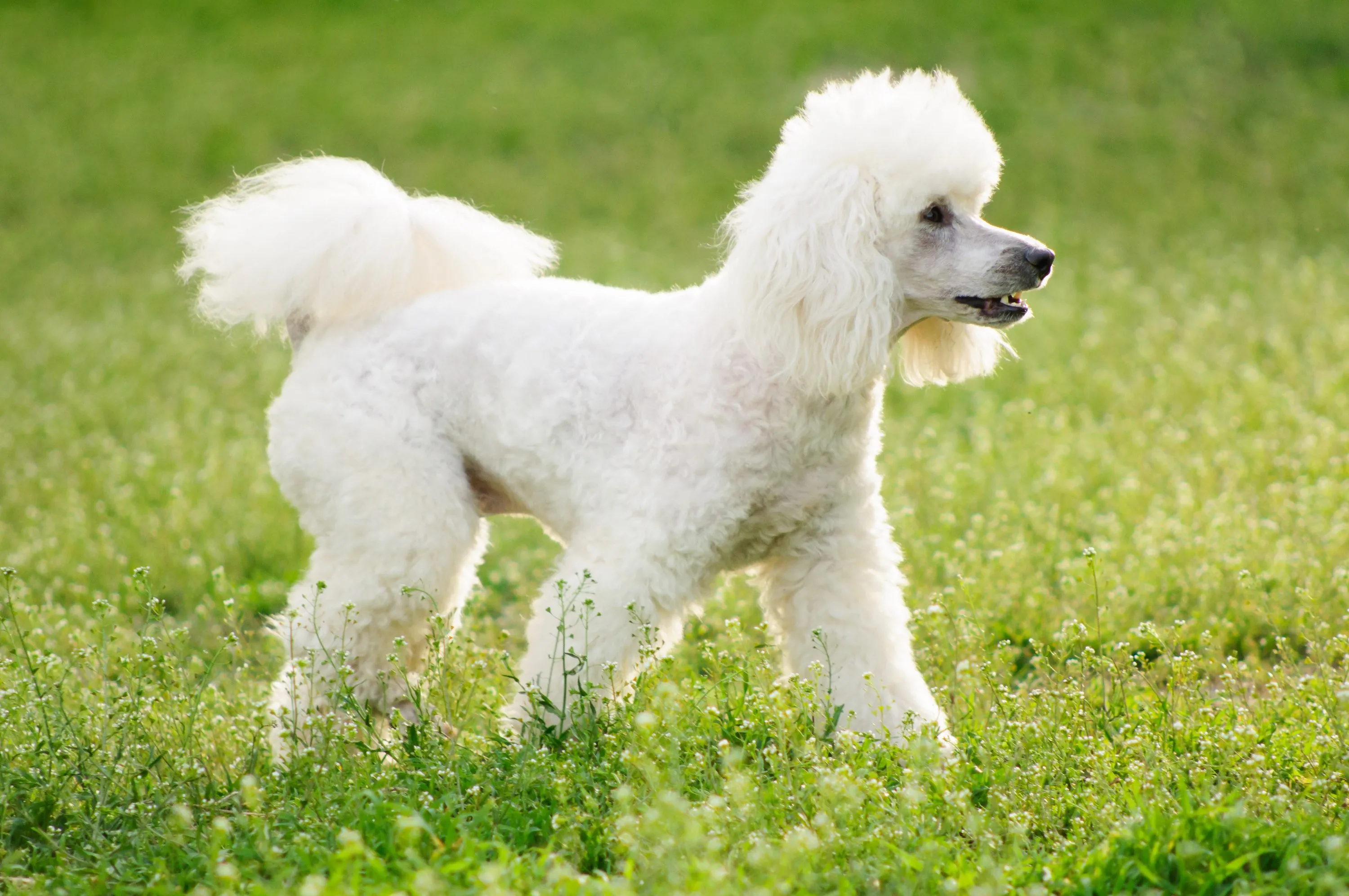 White Standard Poodle stands elegantly in a green, open field.
White Standard Poodle stands elegantly in a green, open field.
Overview: The Standard Poodle is perhaps the quintessential “hypoallergenic” dog. Known for their intelligence, elegance, and friendly nature, they were originally bred as water retrievers. They are highly adaptable and form strong bonds with their families, making them excellent companions for households of all sizes.
Shedding & Allergy Profile: Standard Poodles have a dense, curly, single coat that sheds minimally. Instead of falling out, their loose hairs get caught in the surrounding curls, which is why regular brushing is essential. This low-shedding quality makes them a top choice for families with allergies.
Family Suitability: Poodles are incredibly intelligent and eager to please, making them highly trainable. They are known to be patient and playful with children, thriving on interaction and mental stimulation. Their affectionate nature ensures they become a deeply cherished family member.
Exercise & Activity Level: Standard Poodles are energetic dogs that require daily exercise, such as long walks, fetching games, or even canine sports. They enjoy being active with their families and need an outlet for their intelligence and stamina.
Grooming Requirements: Their beautiful curly coat needs significant upkeep. Regular brushing (2-3 times a week) is crucial to prevent matting, and professional grooming every 4-8 weeks for clipping is typically necessary.
Training & Socialization: Highly intelligent, Poodles respond exceptionally well to positive reinforcement training. Early socialization helps them adapt to various situations and ensures they are well-behaved around new people and other animals.
Standard Schnauzer
 Gray Standard Schnauzer with prominent beard and eyebrows stands alert in a sunny field.
Gray Standard Schnauzer with prominent beard and eyebrows stands alert in a sunny field.
Overview: The Standard Schnauzer is a robust, well-muscled dog, standing as the medium-sized member of the Schnauzer family. Known for their distinctive wiry coat, bushy eyebrows, and beard, they are intelligent, alert, and spirited dogs with a strong protective instinct.
Shedding & Allergy Profile: Standard Schnauzers possess a wiry topcoat and a soft undercoat. They are low-shedding dogs, with most of the loose hair being removed during regular brushing or hand-stripping. This makes them a good option for those seeking large family dogs that don’t shed a lot.
Family Suitability: These dogs are loyal and devoted to their families, often forming strong bonds with children. They can be playful and affectionate but also possess a confident and sometimes strong-willed personality, requiring consistent leadership.
Exercise & Activity Level: Standard Schnauzers are energetic and require at least an hour of vigorous exercise daily. They enjoy activities like long walks, hiking, playing fetch, and engaging in puzzle toys that challenge their sharp minds.
Grooming Requirements: Their wiry coat requires regular brushing (2-3 times a week) to prevent matting and remove loose hair. Many owners opt for professional grooming every 6-8 weeks for clipping or hand-stripping to maintain their classic look and coat texture.
Training & Socialization: Intelligent and quick learners, Standard Schnauzers excel with early training and consistent socialization. They respond best to positive reinforcement and clear boundaries, which are essential for managing their strong protective instincts.
Giant Schnauzer
 Black wet Giant Schnauzer with a blue bow collar stands majestically in a park, looking attentive.
Black wet Giant Schnauzer with a blue bow collar stands majestically in a park, looking attentive.
Overview: The largest of the Schnauzer breeds, the Giant Schnauzer is a powerful, imposing, and intelligent dog. Originally bred for cattle driving and guarding, they are loyal, courageous, and make excellent protectors for their families.
Shedding & Allergy Profile: Like their smaller relatives, Giant Schnauzers have a dense, wiry coat that sheds minimally. Regular grooming is key to managing any loose hairs and dander.
Family Suitability: Giant Schnauzers are devoted to their families and can be very good with children they are raised with, often acting as watchful guardians. They need significant mental and physical engagement to be happy and well-behaved family members.
Exercise & Activity Level: These large dogs have high energy levels and require extensive daily exercise—often 1-2 hours of vigorous activity. This can include long walks, runs, hikes, and engaging play sessions. They thrive when given a job to do or participating in dog sports.
Grooming Requirements: Their wiry double coat needs regular brushing several times a week to prevent tangles and remove dead hair. Professional grooming for clipping or hand-stripping every 6-8 weeks is essential to maintain their coat and characteristic appearance.
Training & Socialization: Due to their size, strength, and intelligence, early and consistent training and socialization are critical for Giant Schnauzers. They need a confident and experienced owner who can provide firm yet fair guidance.
Portuguese Water Dog
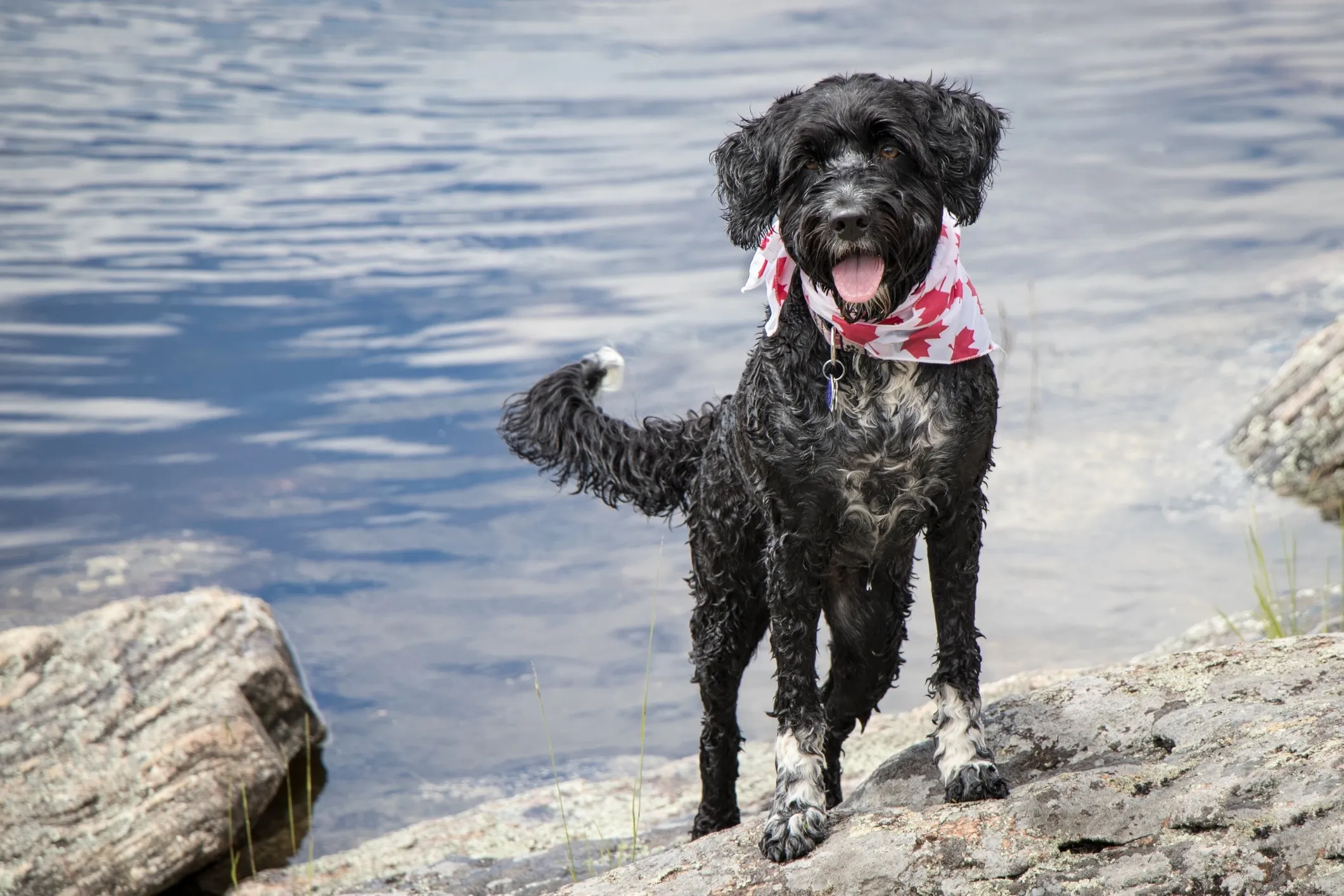 Black and white Portuguese Water Dog wears a red maple leaf bandana, sitting calmly by the water.
Black and white Portuguese Water Dog wears a red maple leaf bandana, sitting calmly by the water.
Overview: Originally bred to assist fishermen in Portugal, the Portuguese Water Dog is a robust, athletic, and intelligent breed. They are known for their distinctive curly or wavy coat and their love for water.
Shedding & Allergy Profile: Portuguese Water Dogs have a thick, single coat that is either curly or wavy and sheds very little. Their low-shedding nature makes them an excellent choice for allergy sufferers, as most loose hair gets trapped in their coat.
Family Suitability: Highly intelligent and energetic, Portuguese Water Dogs are devoted to their families and generally good with children when properly socialized. They thrive on being involved in family activities and enjoy having a “job” to do.
Exercise & Activity Level: These dogs are high-energy pups that require ample daily exercise to stay happy and healthy. Swimming, long walks, hiking, and engaging in dog sports like agility are ideal activities for this active breed.
Grooming Requirements: Their low-shedding coat requires regular brushing several times a week to prevent matting. Professional grooming every 6-8 weeks for trimming is also necessary to maintain their coat length and health.
Training & Socialization: Portuguese Water Dogs are intelligent and eager to please, making them highly trainable. Early training and extensive socialization are important to channel their energy and intelligence positively and ensure they are well-adjusted family members.
Standard Labradoodle
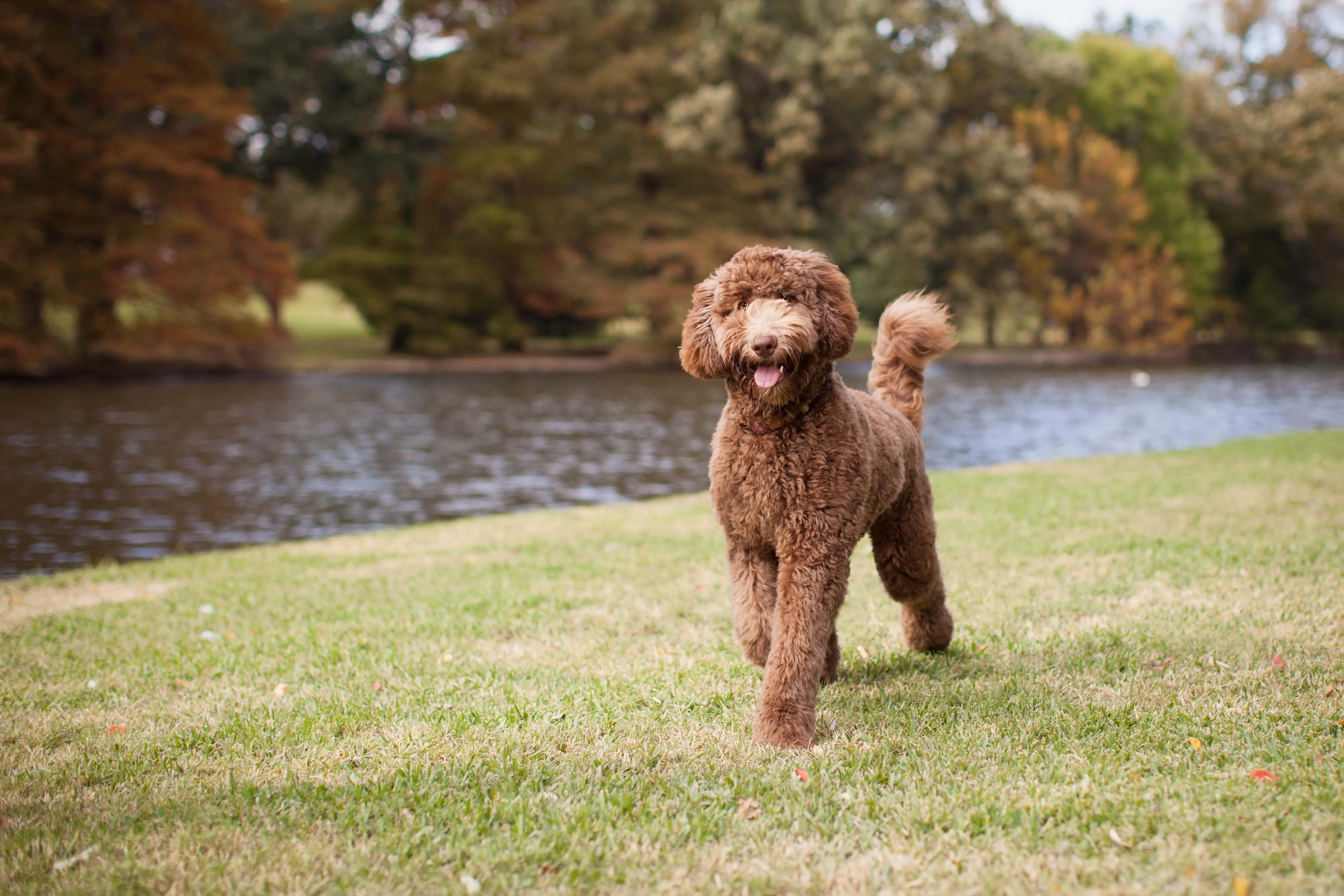 Brown Standard Labradoodle walks gracefully on a leash in a park, looking toward the camera.
Brown Standard Labradoodle walks gracefully on a leash in a park, looking toward the camera.
Overview: A crossbreed between a Labrador Retriever and a Standard Poodle, the Standard Labradoodle was originally bred to be a hypoallergenic service dog. They combine the friendly, outgoing nature of a Lab with the intelligence and low-shedding coat of a Poodle.
Shedding & Allergy Profile: Labradoodles have a coat that can range from wavy to curly, and typically sheds minimally, especially those with more Poodle-like coats. This makes them a popular choice among families with allergies.
Family Suitability: Labradoodles are renowned for being intelligent, friendly, and gentle, making them excellent family pets. They are typically patient and playful with children and get along well with other pets, provided they are socialized from an early age.
Exercise & Activity Level: As energetic dogs, Labradoodles require regular daily exercise, including walks, playtime, and mental stimulation. They thrive in active households where they can be involved in various activities.
Grooming Requirements: Their coats can vary, but most Labradoodles require regular brushing (several times a week) to prevent matting, especially for curlier types. Professional grooming every 6-10 weeks is often recommended to keep their coat in good condition.
Training & Socialization: Highly intelligent and eager to please, Labradoodles are very trainable. Early socialization and consistent positive reinforcement training are key to developing their good manners and ensuring they are well-adjusted family members.
Standard Goldendoodle
 Golden Goldendoodle lies comfortably on a couch, with a person sitting in the background.
Golden Goldendoodle lies comfortably on a couch, with a person sitting in the background.
Overview: Another popular “doodle” breed, the Standard Goldendoodle is a cross between a Golden Retriever and a Standard Poodle. They inherit the Golden Retriever’s friendly and devoted nature combined with the Poodle’s intelligence and low-shedding qualities.
Shedding & Allergy Profile: Goldendoodles are known for their low-shedding coats, which can be wavy or curly. While not entirely shed-free, they are generally a good option for individuals with mild to moderate dog allergies.
Family Suitability: Goldendoodles are famous for their friendly, affectionate, and patient temperaments, making them exceptional family dogs. They are typically great with children and other pets, and their joyful nature brightens any home.
Exercise & Activity Level: These dogs are moderately energetic and enjoy daily walks, playtime in the yard, and engaging in family activities. They appreciate both physical and mental stimulation to keep them happy.
Grooming Requirements: Their fluffy, often wavy or curly coats require frequent grooming to prevent matting. Daily or every-other-day brushing with a slicker brush is recommended, along with professional grooming every 6-8 weeks for trimming.
Training & Socialization: Goldendoodles are highly intelligent and trainable, responding well to positive reinforcement. Early socialization is crucial to help them develop into well-mannered and confident companions.
Irish Water Spaniel
 Brown Irish Water Spaniel in profile, with its signature topknot and smooth face, gazing intently.
Brown Irish Water Spaniel in profile, with its signature topknot and smooth face, gazing intently.
Overview: The Irish Water Spaniel is a distinctive and ancient gundog breed, known for its unique “rat tail,” topknot, and liver-colored curly coat. They are intelligent, jovial, and active dogs with a strong affinity for water.
Shedding & Allergy Profile: This breed has a dense, curly, water-repellent double coat that sheds minimally. The loose hairs tend to get caught in the curls rather than falling out, making them suitable for allergy sufferers.
Family Suitability: Friendly, intelligent, and highly trainable, Irish Water Spaniels are loyal companions that can be excellent family dogs. They are playful and good with children, especially if raised together and properly socialized.
Exercise & Activity Level: Irish Water Spaniels are high-energy dogs that require extensive daily exercise, including vigorous playtime, long walks, and opportunities to swim. They thrive in active households that can meet their need for physical and mental stimulation.
Grooming Requirements: Their curly coat needs regular brushing (2-3 times a week) to prevent matting. Occasional professional grooming may be needed for trimming, especially around the face and paws, to keep them tidy.
Training & Socialization: These intelligent dogs are eager to please and respond well to positive reinforcement training. Early socialization is important to ensure they are well-adjusted and comfortable in various situations.
Standard Aussiedoodle
 Standard Aussiedoodle dog stands on a sandy beach, looking out at the water.
Standard Aussiedoodle dog stands on a sandy beach, looking out at the water.
Overview: An Aussiedoodle is a cross between an Australian Shepherd and a Standard Poodle. This blend results in a highly intelligent, energetic, and typically low-shedding dog that excels in active, engaging families.
Shedding & Allergy Profile: Aussiedoodles often inherit a wavy or curly coat from their Poodle parent, which contributes to their low-shedding characteristics. While shedding can vary, many are suitable for families with allergies.
Family Suitability: Aussiedoodles are known for being very smart and very energetic, making them wonderful companions for active families. They are typically good with children and other pets, provided they receive proper training and socialization.
Exercise & Activity Level: Both parent breeds are energetic, so Aussiedoodles require a significant amount of daily exercise and mental stimulation. Without enough activity, they can become bored and potentially destructive. Daily long walks, runs, agility, and interactive toys are essential.
Grooming Requirements: Their coats need regular brushing (several times a week) to prevent mats and tangles. Professional grooming every 8-12 weeks is often necessary for trimming and maintenance.
Training & Socialization: Highly intelligent and eager to learn, Aussiedoodles excel in training. Early and consistent positive reinforcement, along with extensive socialization, is vital to manage their energy and ensure they grow into well-behaved family members.
Soft Coated Wheaten Terrier
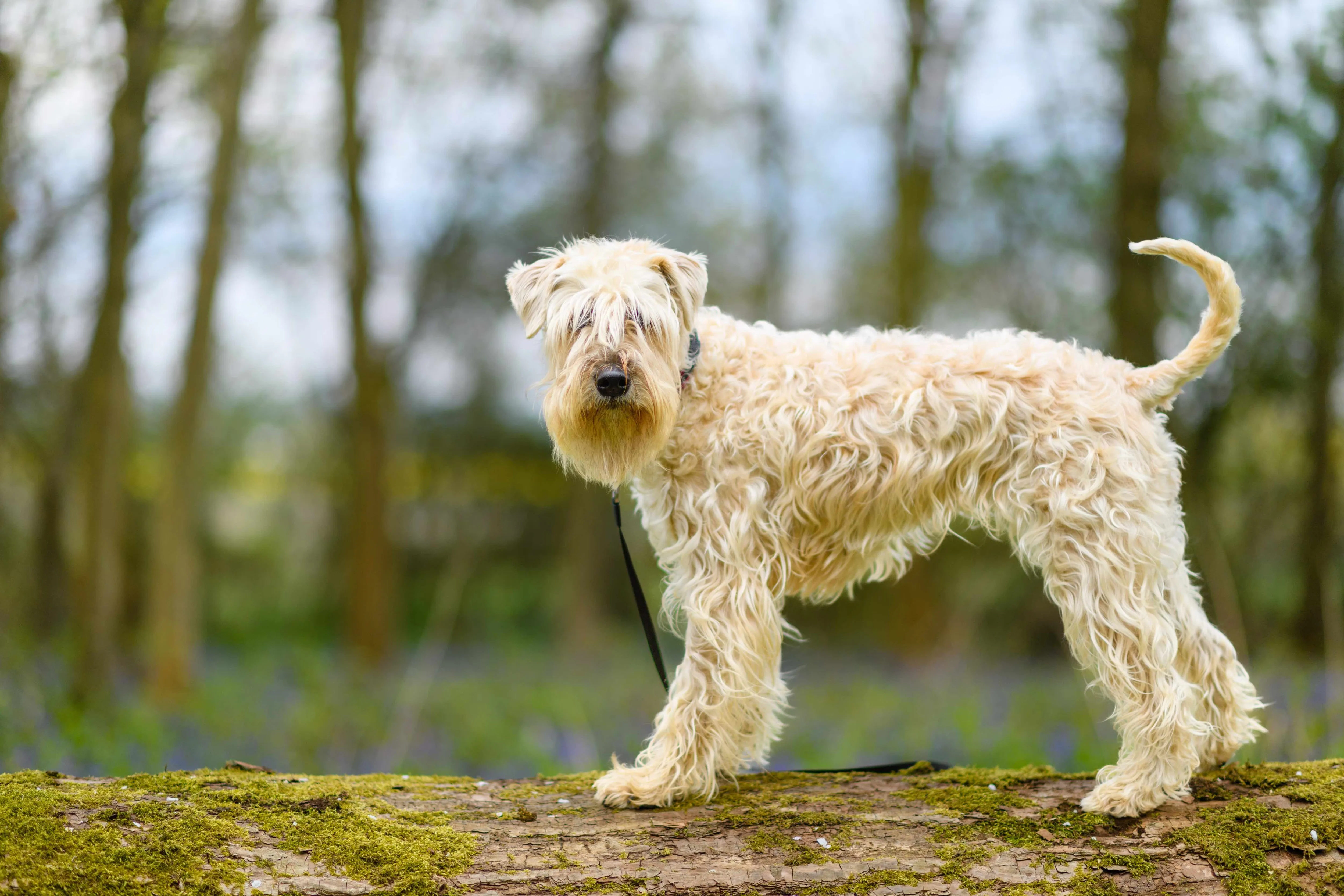 Soft Coated Wheaten Terrier sits on a fallen log in a forest, looking with gentle curiosity.
Soft Coated Wheaten Terrier sits on a fallen log in a forest, looking with gentle curiosity.
Overview: The Soft Coated Wheaten Terrier is a medium-to-large Irish breed known for its silky, wavy, “wheaten” colored coat and joyful, affectionate personality. They are spirited and fun-loving dogs who thrive on human companionship.
Shedding & Allergy Profile: As the name implies, this dog has an incredibly soft, silky coat that sheds minimally. Loose hairs tend to stay trapped in their coat, making them a good choice for individuals with allergies.
Family Suitability: Wheatens are typically outgoing, friendly, and make wonderful family companions. They are often good with children, displaying a playful and affectionate demeanor. Their zest for life makes them engaging family members.
Exercise & Activity Level: Being terriers, Wheatens maintain a high energy level throughout their lives. They require ample daily exercise and mental stimulation, such as long walks, play sessions, and opportunities to run, to keep them happy and well-behaved.
Grooming Requirements: Their soft, wavy coat needs daily or every-other-day brushing to prevent tangles and mats. Professional grooming for trimming every 4-8 weeks is usually necessary to keep their coat manageable and healthy.
Training & Socialization: Wheatens are intelligent but can have a stubborn streak. Consistent, positive reinforcement training from an early age, along with extensive socialization, is crucial to channel their exuberance and ensure they are well-adjusted.
Standard Schnoodle
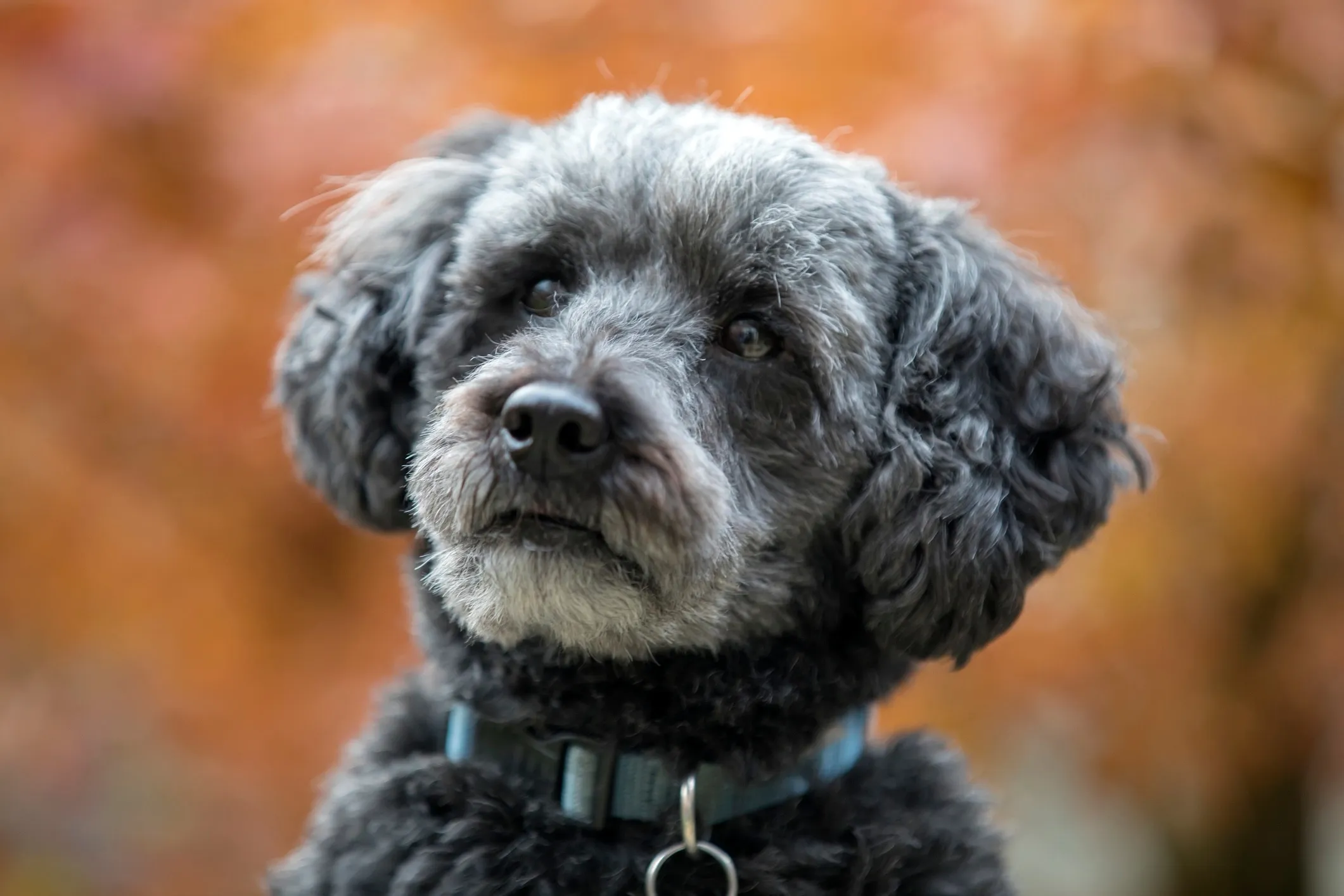 Gray Schnoodle puppy with fluffy, wavy fur, looking attentively.
Gray Schnoodle puppy with fluffy, wavy fur, looking attentively.
Overview: The Schnoodle is a designer breed combining two low-shedding breeds: a Schnauzer (Miniature, Standard, or Giant) and a Poodle (Toy, Miniature, or Standard). A Standard Schnoodle, from a Standard Schnauzer and Standard Poodle, will be a large, intelligent, and playful companion.
Shedding & Allergy Profile: With two low-shedding parent breeds, Schnoodles are an excellent choice for allergy sufferers. Their coat can be curly or wavy, and it consistently sheds very little, trapping dander effectively.
Family Suitability: Schnoodles often inherit the best traits from both parents, resulting in a loyal, intelligent, and affectionate dog. They are typically good with children and make wonderful family pets, thriving on interaction and play.
Exercise & Activity Level: A Standard Schnoodle will have moderate to high energy levels and requires daily exercise, including walks, playtime, and mental challenges. They enjoy being active with their families and can adapt to various activities.
Grooming Requirements: Their coats vary, but all Schnoodles require regular brushing (several times a week) to prevent matting. Professional grooming every 6-8 weeks for clipping is usually necessary to maintain their coat’s health and appearance.
Training & Socialization: Schnoodles are intelligent and eager to please, making them highly trainable. Early training and socialization are important to ensure they develop good manners and are comfortable in different environments.
Standard Xoloitzcuintli
 Black Hairless Standard Xoloitzcuintli stands tall and alert in green grass, showcasing its sleek body.
Black Hairless Standard Xoloitzcuintli stands tall and alert in green grass, showcasing its sleek body.
Overview: Also known as the Mexican Hairless Dog, the Xoloitzcuintli (pronounced show-low-eet-SKEEN-tlee) is an ancient and rare breed. They come in three sizes (toy, miniature, and standard), with the standard being a truly large dog. They are known for their striking hairless appearance (though coated varieties exist) and calm, attentive nature.
Shedding & Allergy Profile: Both hairless and short-coated Xolos are considered hypoallergenic. The hairless variety has virtually no shedding, and the coated variety has a very short, sparse coat that sheds minimally, making them excellent for allergy sufferers.
Family Suitability: Xolos are loyal and affectionate with their families, often forming strong bonds. They can be good with children, especially if raised with them, and are generally calm and quiet indoors, though they can be wary of strangers.
Exercise & Activity Level: Standard Xolos are athletic dogs that require moderate daily exercise, such as walks or playtime. While they enjoy activity, they are also content to relax with their family.
Grooming Requirements: Hairless Xolos require specific skin care, including regular bathing, moisturizing, and sun protection. Coated Xolos have minimal grooming needs beyond occasional brushing.
Training & Socialization: Intelligent and sensitive, Xolos respond well to gentle, consistent training. Early socialization is crucial to help them overcome their natural wariness of new people and environments.
Whoodle
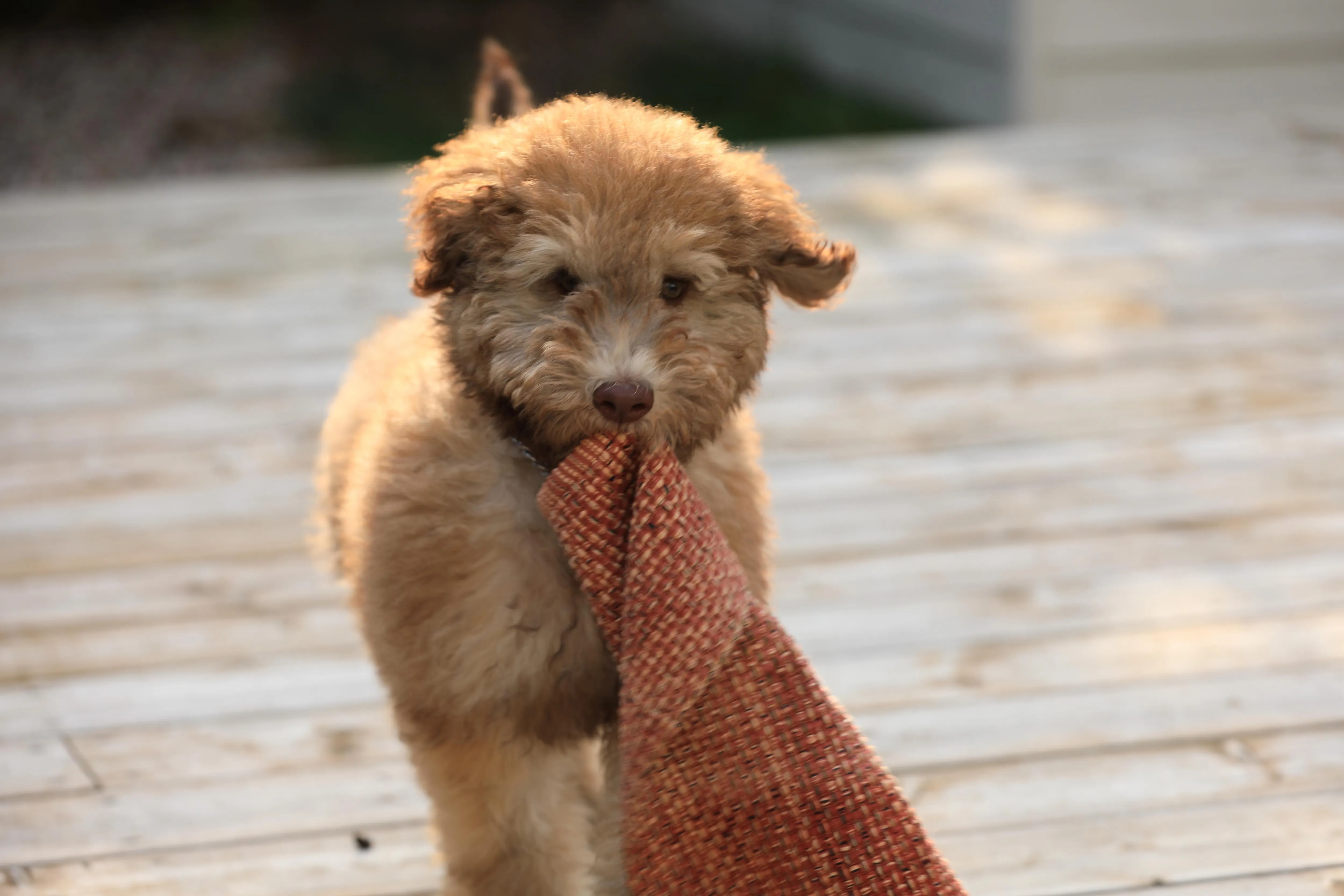 Tan Whoodle puppy playfully drags a washcloth across a carpeted floor.
Tan Whoodle puppy playfully drags a washcloth across a carpeted floor.
Overview: The Whoodle is a crossbreed resulting from the pairing of a Soft-Coated Wheaten Terrier and a Poodle (often a Standard Poodle for a larger size). This combination brings together two intelligent, affectionate, and low-shedding breeds.
Shedding & Allergy Profile: Whoodles inherit their low-shedding qualities from both parent breeds. Their soft, wavy, or curly coat sheds very little, making them a great option for allergy-prone families.
Family Suitability: Whoodles are known for their friendly, playful, and affectionate nature. They typically bond closely with their families and are good with children, eager to be involved in all household activities.
Exercise & Activity Level: Whoodles are energetic dogs that require daily exercise, including walks, playtime, and mental engagement. They thrive in active homes where they can expend their energy.
Grooming Requirements: Their soft, wavy coats need regular brushing several times a week to prevent tangles and mats. Professional grooming every 6-10 weeks for trimming is often necessary to maintain their coat health and appearance.
Training & Socialization: Intelligent and eager to please, Whoodles respond well to positive reinforcement training. Early socialization is important to ensure they are well-adjusted and comfortable in various situations.
Standard Bernedoodle
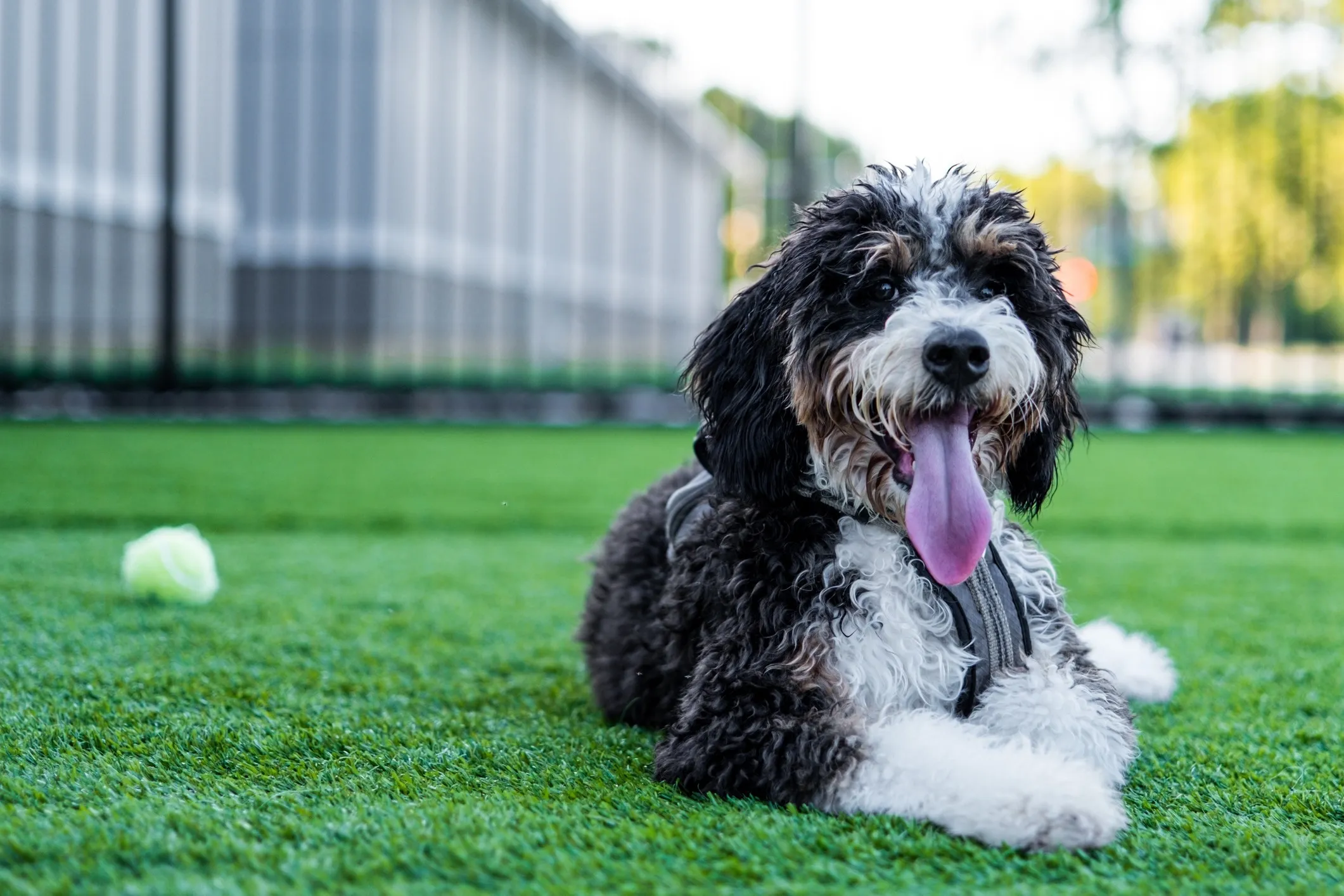 Large Bernedoodle dog lies happily in green grass with its tongue playfully out.
Large Bernedoodle dog lies happily in green grass with its tongue playfully out.
Overview: A Bernedoodle is a cross between a Bernese Mountain Dog and a Standard Poodle. They combine the Bernese’s gentle, loyal nature with the Poodle’s intelligence and low-shedding coat, creating a truly magnificent family companion.
Shedding & Allergy Profile: Bernedoodles typically inherit a wavy or curly coat from their Poodle parent, which results in minimal shedding. This makes them a popular choice for families seeking a large, low-allergen dog.
Family Suitability: Bernedoodles are celebrated for their friendly, affectionate nature and gentle demeanor, making them exceptionally popular with families, especially those with children and other pets. They are devoted and eager to please.
Exercise & Activity Level: These large dogs need moderate to high levels of exercise to stay happy and healthy. Daily walks, playtime, and opportunities for mental stimulation are important to prevent boredom.
Grooming Requirements: Their coats, varying from wavy to curly, require regular brushing several times a week to prevent matting. Professional grooming every 6-10 weeks for trimming is often necessary to maintain their coat.
Training & Socialization: Bernedoodles are intelligent and generally eager to learn, making them very trainable. Early and consistent positive reinforcement training and socialization are crucial for these large dogs to grow into well-mannered family members.
Afghan Hound
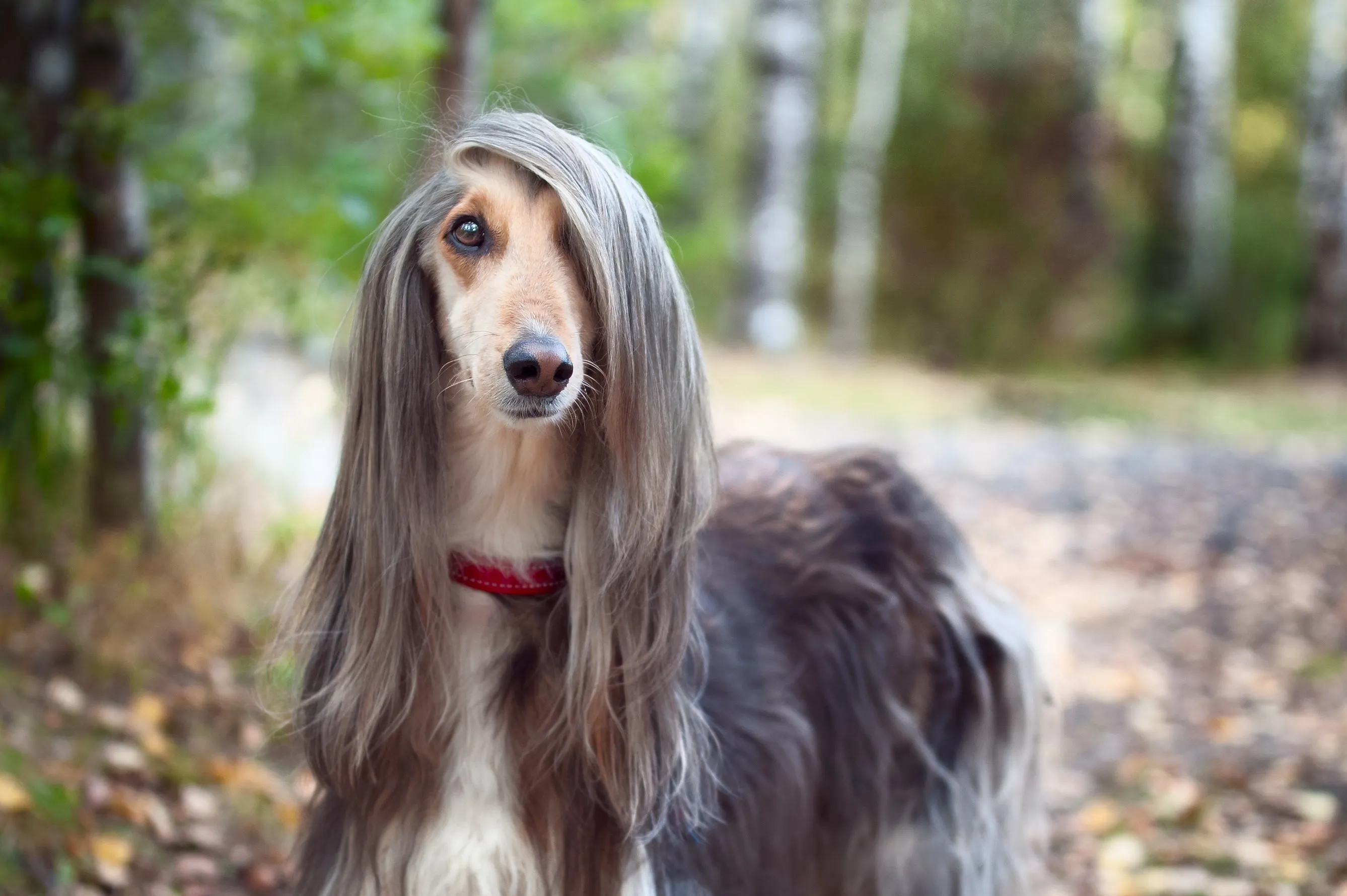 Gray and tan Afghan Hound with long, flowing fur, looks curiously at the camera.
Gray and tan Afghan Hound with long, flowing fur, looks curiously at the camera.
Overview: The Afghan Hound is an aristocratic and ancient breed, instantly recognizable by its long, flowing, silky coat and distinctive aloof gaze. They are sighthounds, built for speed and endurance, and possess a unique, independent personality.
Shedding & Allergy Profile: Despite their voluminous coat, Afghan Hounds are low-shedding. Their hair is more like human hair and requires specific care, but it doesn’t shed in clumps or produce a lot of dander like many other breeds.
Family Suitability: Afghan Hounds are loving and devoted toward their immediate family but can be quite aloof and independent, especially with strangers. They can be good with older, respectful children who understand their dignified nature.
Exercise & Activity Level: These dogs are built for running and require significant daily exercise, including long runs or vigorous play in a securely fenced area. They need an outlet for their athletic capabilities.
Grooming Requirements: Their long, silky coat requires extensive and regular grooming to prevent tangles and mats. Daily brushing is often necessary, along with regular bathing and conditioning. Professional grooming can also be beneficial.
Training & Socialization: Afghan Hounds are intelligent but can be independent and sensitive. Training requires patience, consistency, and positive reinforcement. Early and consistent socialization is vital to help them be well-adjusted.
Barbet
 Close-up of a curly red Barbet dog's face, showcasing its shaggy, woolly fur.
Close-up of a curly red Barbet dog's face, showcasing its shaggy, woolly fur.
Overview: The Barbet, pronounced “bar-bay,” is a cheerful and rare French water dog known for its shaggy, woolly coat and characteristic beard (the name comes from the French word barbe, meaning beard). They are intelligent, loyal, and possess a playful spirit.
Shedding & Allergy Profile: Barbets have a dense, woolly, curly coat that sheds minimally, similar to other water dogs. Their coat traps loose hairs and dander, making them a good choice for allergy sufferers.
Family Suitability: Barbets are known for being affectionate, loyal, and good-natured. They are typically patient and playful with children, thriving as part of an active family. Their joyful disposition makes them delightful companions.
Exercise & Activity Level: These active dogs require regular daily exercise, including walks, playtime, and swimming, which they adore. They need both physical and mental stimulation to keep them happy and well-behaved.
Grooming Requirements: Their shaggy, woolly coat requires consistent grooming to prevent matting. Regular brushing (2-3 times a week) and professional grooming for trimming every 6-8 weeks are essential to maintain their coat’s health and appearance.
Training & Socialization: Barbets are intelligent and eager to please, responding well to positive reinforcement training. Early socialization helps them adapt to various environments and become confident family members.
Large Peruvian Inca Orchid
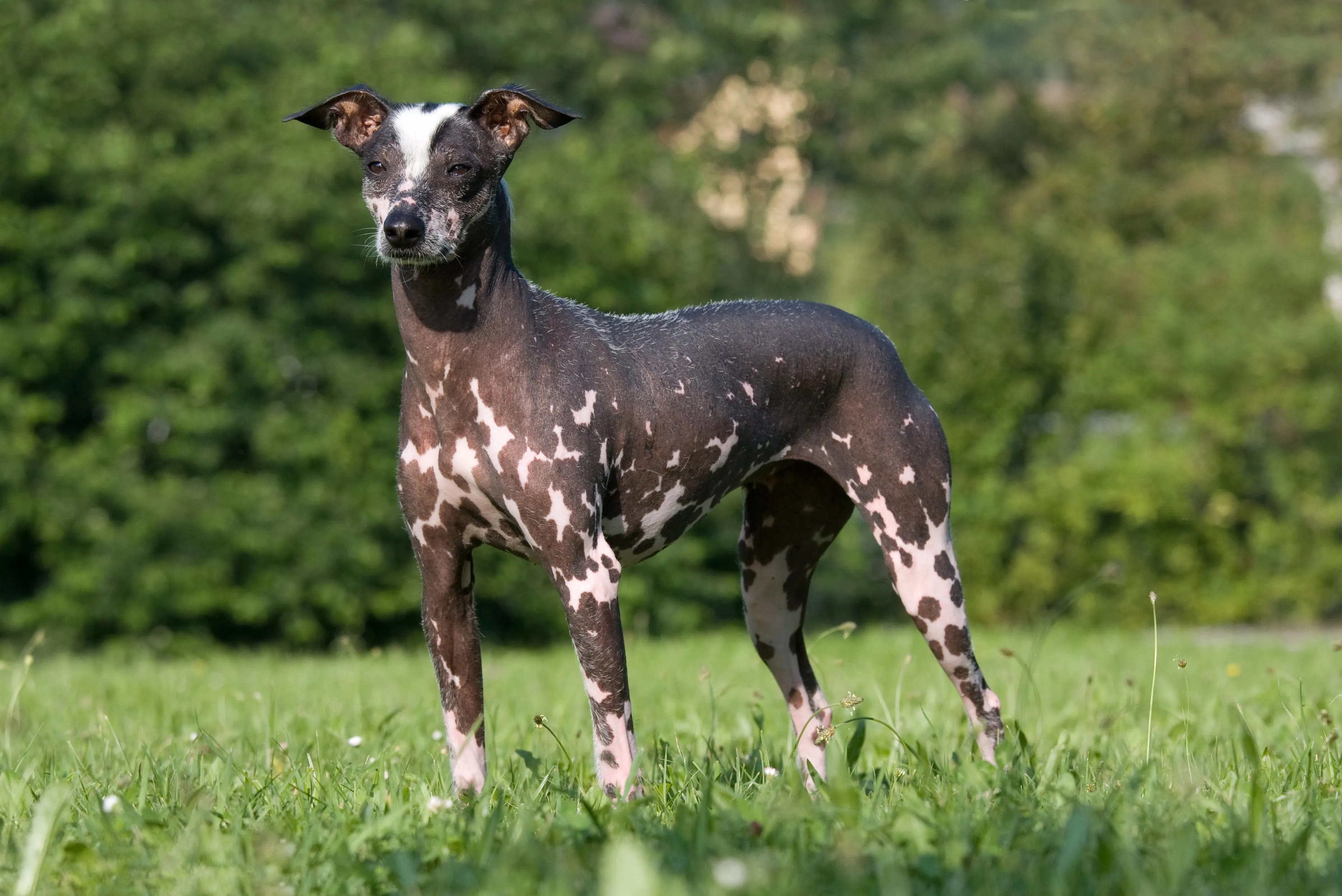 Hairless Peruvian Inca Orchid dog stands gracefully in a natural setting.
Hairless Peruvian Inca Orchid dog stands gracefully in a natural setting.
Overview: The Peruvian Inca Orchid is an ancient and unique breed, the national dog of Peru. They come in three sizes (small, medium, and large), with the large variety fitting the criteria for a best family large dogs that don’t shed. They are known for their elegant, hairless bodies (though coated varieties exist) and alert, affectionate nature.
Shedding & Allergy Profile: As a hairless breed, the Peruvian Inca Orchid is an excellent choice for allergy sufferers due to virtually no shedding or dander release from hair. Coated varieties also have very short, sparse hair, resulting in minimal shedding.
Family Suitability: These dogs are generally calm, affectionate, and protective towards their families. They can be good with older, respectful children and are devoted companions, often forming strong bonds with their owners.
Exercise & Activity Level: Large Peruvian Inca Orchids have moderate exercise needs, enjoying daily walks and playtime. They are athletic but also content to relax indoors with their family.
Grooming Requirements: Hairless varieties require regular skin care, including bathing, moisturizing, and sun protection. Coated varieties have minimal grooming needs.
Training & Socialization: Intelligent and sensitive, Peruvian Inca Orchids respond best to gentle and consistent training methods. Early socialization is important to help them feel comfortable and confident in various social situations.
Living Successfully with Your Large, Low-Shedding Family Dog
Bringing a large, low-shedding dog into your family is a rewarding experience. To ensure a harmonious home for both your dog and your allergy-sensitive family members, consider these crucial aspects.
Comprehensive Grooming Strategies
While low-shedding breeds minimize hair and dander, they are not maintenance-free. Their coats often require consistent care to prevent matting, maintain skin health, and further reduce allergens.
- Regular Brushing: Brush your dog 2-3 times a week, or even daily for curly or wavy coats, to remove loose hairs that get trapped in the coat and distribute natural oils.
- Bathing Schedule: Bathe your dog every 4-6 weeks using a hypoallergenic shampoo. This helps wash away dander, saliva residue, and environmental allergens. Some specialized dander removers can also be beneficial.
- Professional Grooming: Many low-shedding breeds, especially Poodle mixes, require professional clipping and trimming every 6-10 weeks to maintain their coat length and prevent matting. Factor this into your budget and time.
- Ear and Nail Care: Regularly check and clean their ears and trim their nails, as these are important aspects of overall hygiene.
Maintaining an Allergy-Friendly Home
Beyond grooming your dog, maintaining a clean home environment is essential for minimizing allergens.
- Frequent Vacuuming: Vacuum carpets and upholstered furniture regularly, using a vacuum cleaner with a HEPA filter, to pick up any loose dander or hair.
- Dusting and Wiping: Dust hard surfaces with a damp cloth to capture allergens rather than just spreading them around.
- Wash Bedding: Wash your dog’s bedding and your own bedding frequently in hot water to remove dander and dust mites.
- Air Purification: Use high-quality air purifiers with HEPA filters in main living areas and bedrooms to help remove airborne allergens.
- Designated Dog-Free Zones: Consider designating certain areas, like bedrooms, as dog-free zones to provide an allergen-reduced sanctuary.
- Ventilation: Keep your home well-ventilated to reduce allergen buildup.
Effective Training for Large Family Companions
Training is non-negotiable for large family dogs, low-shedding or not. Their size and strength demand good manners and obedience to ensure they are safe and pleasant companions for everyone.
- Early Start: Begin training and socialization as soon as your puppy comes home.
- Positive Reinforcement: Use reward-based training methods to build a strong bond and encourage desired behaviors.
- Basic Commands: Focus on essential commands like “sit,” “stay,” “come,” “down,” and “leave it.”
- Leash Training: Teach proper leash etiquette early to manage their strength during walks.
- Boundary Training: Help them understand household rules, such as not jumping on furniture or guests.
- Socialization: Expose your dog to various people, places, sounds, and other animals from a young age to develop confidence and good social skills.
Prioritizing Health & Wellness for Large Breeds
Large dogs have specific health considerations that require proactive care.
- Regular Vet Check-ups: Schedule annual veterinary visits for preventative care, vaccinations, and parasite control.
- Balanced Nutrition: Feed a high-quality diet formulated for large breeds, which supports healthy growth and prevents obesity, especially during puppyhood.
- Joint Health: Discuss supplements or specific diets for joint health with your vet, as large breeds are prone to conditions like hip and elbow dysplasia.
- Weight Management: Monitor your dog’s weight carefully, as excess weight puts strain on joints and organs.
- Emergency Preparedness: Be aware of symptoms for breed-specific conditions or general large breed emergencies like bloat.
Consulting Your Healthcare Professional
For family members with allergies, managing their symptoms alongside welcoming a new dog is paramount.
- Allergy Specialist: Consult with an allergist or healthcare provider to discuss strategies for managing pet allergies. They may recommend medications, nasal sprays, or immunotherapy.
- Minimize Direct Contact: While loving, try to avoid direct contact with your dog’s saliva (e.g., licking your face) or urine, as these also contain allergens.
- Hand Washing: Always wash your hands after interacting with your dog.
Conclusion
Choosing a large family dog that doesn’t shed offers the best of both worlds: the loyal companionship and protective nature of a big dog, coupled with a minimized impact on family members with allergies. Breeds like the Standard Poodle, Goldendoodle, and Bernedoodle provide diverse options for families looking for an intelligent, affectionate, and low-shedding companion. By committing to regular grooming, maintaining a clean home, ensuring consistent training, and prioritizing their health, you can create a happy, healthy, and allergy-friendly environment for your beloved canine and your entire family. Embrace the joy of large family dogs that don’t shed and welcome a gentle giant into your home.
For more insights into dog care and finding the perfect pet for your lifestyle, explore other articles on Dog Care Story!
